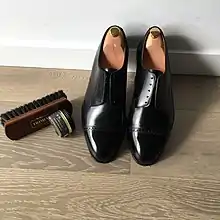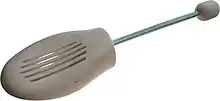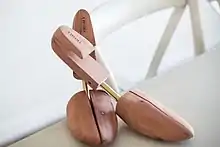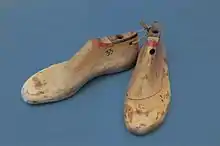Shoe tree (device)
A shoe tree is a device approximating the shape of a foot that is placed inside a shoe to preserve its shape, stop it from developing creases and thereby extend the life of the shoe.

Perhaps more important than maintaining the shape, shoe trees also play a crucial part in wicking away moisture caused by sweat - a major cause of lining rot and leather degradation. This is especially important when shoes are worn without socks.
Higher quality shoe trees are made from softwood, usually cedar, which helps control odor and absorb moisture.
Types
Among wooden shoe trees, there are generally three categories, which correspond to price and quality.
Spring shoe trees

The cheapest are wooden shoe tree without a full heel. Although they help with odour, and will help preserve the original shape at the front of the shoe, the narrow knob on the heel puts excess pressure on one section of the heel and prolonged use may deform the shoe.[1] Notwithstanding, this style of shoe tree is popular with high heels because of its flexibility.
Generic shoe trees

Generic shoe trees are non-lasted shoe trees that are designed to fit a wide range of footwear styles. Generic shoe trees come in many styles; two of the more popular ones are the twin-tube and single-tube shoe tree. The twin-tube shoe tree, cut from a generic last and featuring a fully articulated (round heel), a spring toe and ventilation holes. This style is most popular in England and Europe customers. The single-tube, split-toe shoe tree with overhand handle, works on a spring-spreader mechanism, causing the split toe to expand into the shoe when inserted into the shoe. This style is most popular in the United States.
Lasted shoe trees

At the highest range are lasted shoe trees, which accompany the shoes for which they have the same last.[2]
Plastic shoe trees
Shoe trees may also be made of plastic or stamped sheet metal, with or without a coiled steel spring stem; these are typically cheaper, lighter, and are better suited for traveling. Types lacking a flexing steel spring may use extension springs or adjustable two-piece stems having an over-center mechanical action to wedge them in place. Plastic shoe trees maintain the shape of your shoes but lack the moisture absorbing qualities of wooden shoe trees. Because wooden shoe trees can damage the leather when stored in luggage, plastic shoe trees are often used when traveling, as well as having the added benefit of being lightweight.
When to use
The best time to insert shoe trees is as soon as shoes are removed. After a day of wear, leather shoes may be stretched and contain moisture due to sweat. By inserting shoe trees, the leather will re-form back to its natural shape, and the shoe tree may wick away moisture, which may rot the lining and crack leather.[3]

Boot trees
Boot trees are shoe trees for boots. Boot trees are often used on ankle-high boots and are similar to standard shoe trees but have a higher ankle area. Their main function is to support the heel counter, which helps preserve the integrity of the higher heel and prevents it from creasing or folding over. The fore part of the boot tree acts as a standard shoe tree and works to gently stretch out the vamp and prevent creasing.[4]
Creases that form in the calves of boots can affect comfort when walking. For zip boots, creasing may eventually cause the zip to break. By investing in a pair of boot trees a repair like this can easily be avoided.
A boot shaper, on the other hand, has wooden or plastic formers with centre support or wedge that expands to provide the ideal tension for your boots. Some boot shapers come with a trigger that allows easy fitting and hanging.[5]
References
- FitzPatrick, Justin (2012-06-18). "A Guide To Shoe Trees". Retrieved 2016-06-26.
- "Everyone should invest in a decent pair of shoe trees — here's why - Business Insider". 2015-07-07. Retrieved 2016-06-26.
- "Shoe Tree Guide | SHOE TREE Singapore". 2016-04-02. Retrieved 2016-06-26.
- "The Shoe Tree Guide | Trimly.com.au". www.trimly.com.au. Retrieved 2018-08-31.
- "How Shoe Trees Can Extend Shoe Life | HeelingTouch.com". www.heelingtouch.com. Retrieved 2016-06-26.